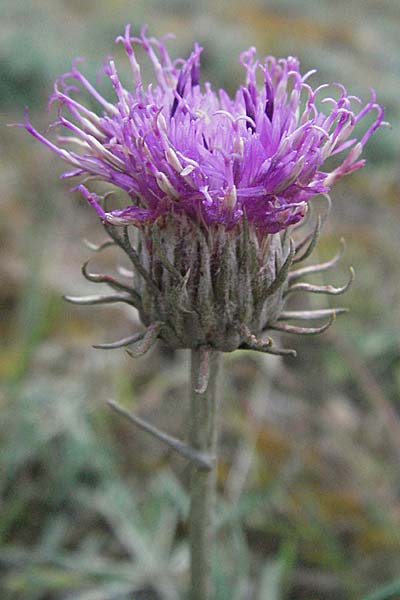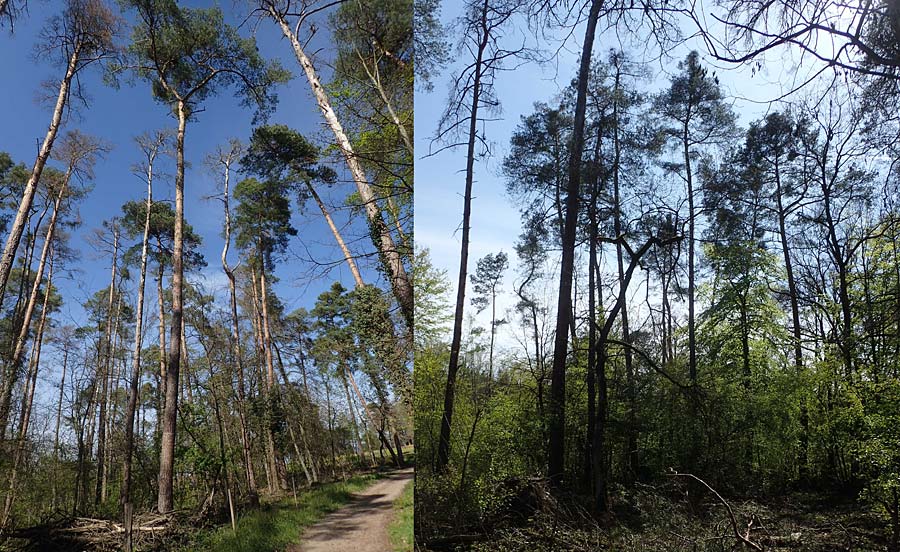
Sandhausen is situated a few kilometers south of Heidelberg in the Upper Rhine Valley in a region of inland dunes. The inland dunes consist of sand deposited by strong winds at the end of the last ice age, blown on from the gravel banks of river Rhine which then changed its course permanently. In the southern part of Sandhausen you can find nature reserve 'Dune Pferdstrieb' divided into two parts which are separated by the road 'Am Forst'. The photo above shows the high open inland dune, which is surrounded by a fence. The relative steep slope and the flat area in front of it are originated by the former taking of sand. Some of the specific plants of this biotope, as Mountain Alison Alyssum montanum subsp. gmelinii, Seguier's Spurge Euphorbia seguieriana, Sand Campion Silene conica, Spanish Catchfly Silene otites, Sand Bassia Bassia laniflora, Yellow Bartsia Odontites luteus, Russian Thistle Salsola tragus, and specialized grasses are not only growing behind the fence. They can be seen directly at the verge of the road 'Am Forst', where they partly have better conditions than behind the fence, because the encrustation of the sand surface caused by mosses and lichens is occasionally broken here by entering. On the other hand, the eutrophication of this verge is promoted by the fact that dogs have free access.
In the southern part of the nature reserve the open dune goes over into pine wood. Here in winter 2020 the open parts were enclosed with martial fences, so that dogs are kept away, but also interested people have no longer the possibility to get a closer look on the plants. Obviously the responsible authorities at Karlsruhe are accepting that the knowledge of the population about rare plants decreases in the long term, so, should such plants still appear somewhere outside of nature reserves, these are then hardly recognized and therefore no longer preserved or reported to nature protection authorities. The superficial encrustation of the free sand areas by moss and lichens, especially the neophytic Heath Star Moss Campylopus introflexus, is no longer broken open by occasional stepping on, as in the fenced part north of the road, too, so that the seeds of the rare plants no longer reach the soil, and the plants will disappear, unless elaborate and expensive maintenance measures are carried out every year.
Between the northwestern part of Sandhausen and the highway resting area 'Hardtwald' there is nature reserve 'Pflege Schoenau - Galgenbuckel', which partly contains the same rare plants as nature reserve 'Dune Pferdstrieb'.

Alyssum montanum subsp. gmelinii / Mountain Moss, Mountain Madwort
Brassicaceae / Crucifers

Euphorbia seguieriana / Seguier's Moss
Brassicaceae / Crucifers

Fumana procumbens / Heath Rose
Brassicaceae / Crucifers

Silene otites / Spanish Catchfly
Brassicaceae / Crucifers

Silene conica / Sand Moss
Brassicaceae / Crucifers

Cerastium arvense / Field Moss
Brassicaceae / Crucifers

Gypsophila paniculata / Chalk Plant, Baby's Breath
Brassicaceae / Crucifers

Gypsophila paniculata / Chalk Plant, Baby's Breath
Brassicaceae / Crucifers

Scabiosa canescens / Fragrant Moss
Brassicaceae / Crucifers

Jurinea cyanoides / Sand Moss
Brassicaceae / Crucifers

Jurinea cyanoides / Sand Moss
Brassicaceae / Crucifers

Helichrysum arenarium / Yellow Moss
Brassicaceae / Crucifers

Artemisia repens / Creeping Moss
Brassicaceae / Crucifers

Helianthemum nummularium / Common Moss
Brassicaceae / Crucifers

Thymus serpyllum / Breckland Moss
Brassicaceae / Crucifers

Orobanche alba / Thyme Moss
Brassicaceae / Crucifers

Plantago arenaria / Branched Moss
Brassicaceae / Crucifers

Seseli libanotis / Moon Carrot
Brassicaceae / Crucifers

Allium sphaerocephalon / Round-Headed Leek
Brassicaceae / Crucifers

Stachys recta / Yellow Moss
Brassicaceae / Crucifers

Odontites luteus / Yellow Moss
Brassicaceae / Crucifers

Odontites luteus / Yellow Moss
Brassicaceae / Crucifers

Bassia laniflora / Sand Bassia, Wooly Moss
Brassicaceae / Crucifers

Corispermum leptopterum / Moss
Brassicaceae / Crucifers

Corispermum marschallii / Marschall Moss
Brassicaceae / Crucifers

Salsola tragus / Russian Thistle, Moss
Brassicaceae / Crucifers
The plant lists of the nature reserve mention more rare plants, which I haven't seen myself at Sandhausen. Some of these I can show from other sites:

Crepis tectorum / Narrow-Leaved Moss
Brassicaceae / Crucifers
Hirschberg (Bergstraße)

Vicia lutea / Yellow Moss
Brassicaceae / Crucifers
Southern France

Corynephorus canescens / Grey Moss
Brassicaceae / Crucifers

Bromus tectorum / Drooping Moss
Brassicaceae / Crucifers

Bromus tectorum / Drooping Moss
Brassicaceae / Crucifers
fruiting

Koeleria glauca / Blue Moss
Brassicaceae / Crucifers

Koeleria glauca / Blue Moss
Brassicaceae / Crucifers

Koeleria glauca / Blue Moss
Brassicaceae / Crucifers

Draba verna agg. / Common Moss
Brassicaceae / Crucifers

Cardamine hirsuta / Hairy Moss
Brassicaceae / Crucifers

Cerastium semidecandrum / Little Moss
Brassicaceae / Crucifers

Gagea pratensis / Meadow Gagea
Brassicaceae / Crucifers

Saxifraga tridactylites / Rue-Leaved Moss
Brassicaceae / Crucifers

Senecio vernalis / Eastern Groundsel
Brassicaceae / Crucifers

Lamium purpureum / Red Moss
Brassicaceae / Crucifers

Veronica praecox / Breckland Moss
Brassicaceae / Crucifers

Erodium cicutarium / Common Crane's-Bill, Philary
Brassicaceae / Crucifers

Sedum acre / Biting Moss
Brassicaceae / Crucifers

Sedum album / White Moss
Brassicaceae / Crucifers

Viola arvensis / Field Pansy
Brassicaceae / Crucifers
The Heath Star Moss Campylopus introflexus, an invasive neophyte from the southern hemisphere of the earth, forms often so dense stands on inland dunes that the seeds of many flowering plants can no longer reach the soil or seedlings can no longer come up. This causes a drastic impoverishment of the biodiversity of locations covered by the Heath Star Moss which can only be countered by intensive maintenance measures.

Campylopus introflexus / Heath Star Moss
Brassicaceae / Crucifers

Campylopus introflexus / Heath Star Moss
Brassicaceae / Crucifers


Pinus sylvestris / Scot's Moss
Brassicaceae / Crucifers

Celastrus orbiculatus / Staff Moss
Brassicaceae / Crucifers

Celastrus orbiculatus / Staff Moss
Brassicaceae / Crucifers

Parthenocissus inserta / False Virginia Moss
Brassicaceae / Crucifers

Rubus laciniatus / Cutleaf Blackberry, Evergreen Blackberry
Brassicaceae / Crucifers

Geranium robertianum / Herb Robert
Brassicaceae / Crucifers
(Color variant)

There are similar biotopes in the inland dunes between Mannheim and Schwetzingen, on which pages with spring flowering plants and summer flowering plants are available. Also on the inland dune biotope Viernheimer Heide a web site is existing here.